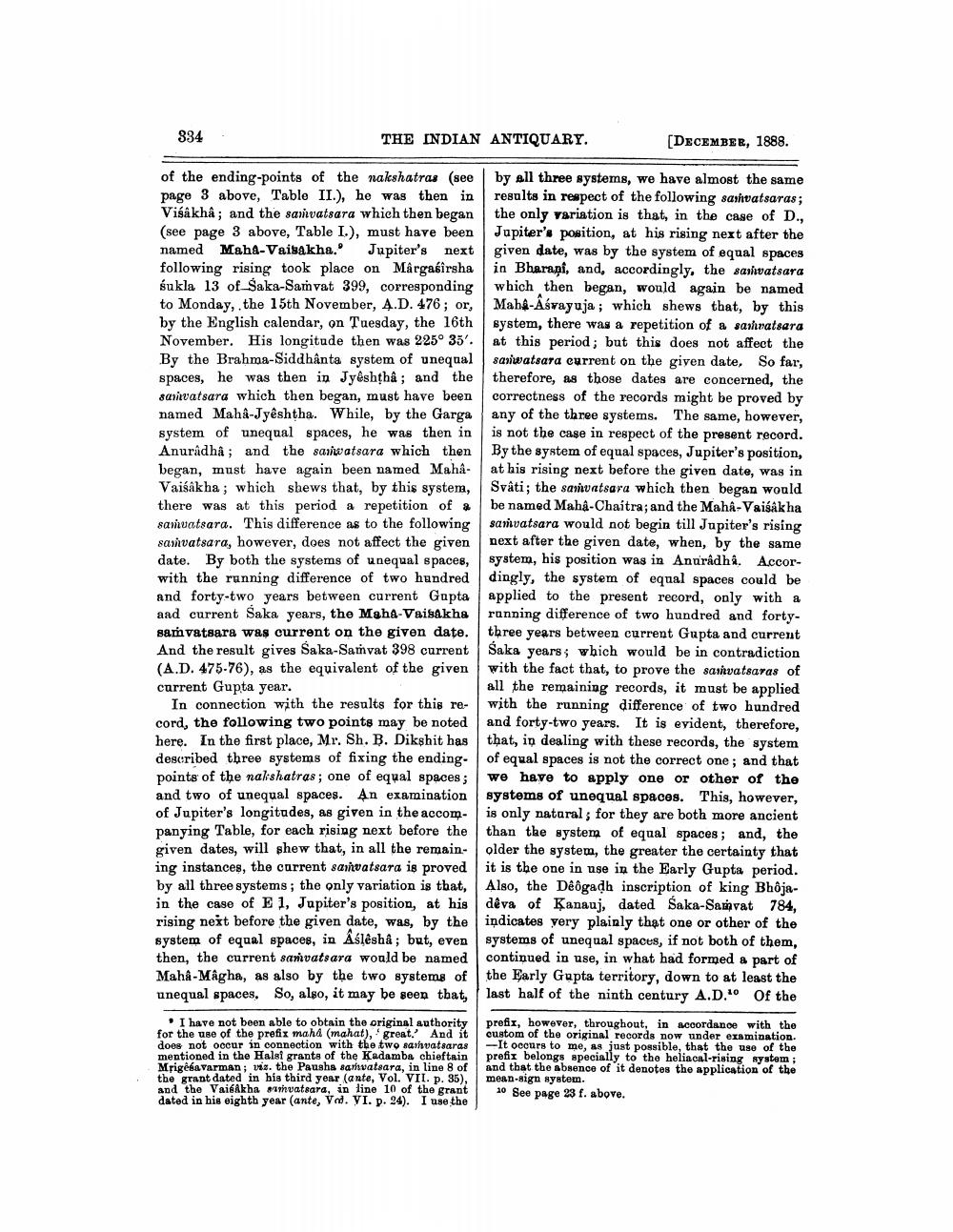________________
334
THE INDIAN ANTIQUARY.
[DECEMBER, 1888.
of the ending-points of the nakshatras (see by all three systems, we have almost the same page 3 above, Table II.), he was then in results in respect of the following sashvatsaras; Visakhâ; and the sannvatsara which then began the only variation is that, in the case of D., (see page 3 above, Table I.), must have been Jupiter's position, at his rising next after the named Maha-Vaisakha Jupiter's next I given date, was by the system of equal spaces following rising took place on Mârgabîrshain Bharani, and, accordingly, the sasivatsara śukla 13 of_Saka-Samvat 399, corresponding which then began, would again be named to Monday, the 15th November, A.D. 476; or, Mahf-Aśvayuja ; which shews that, by this by the English calendar, on Tuesday, the 16th system, there was a repetition of a sarhnatsara November. His longitude then was 225° 35'. at this period; but this does not affect the By the Brahma-Siddhanta system of unequal sariwatsara current on the given date. So far, spaces, he was then in Jy@shtha; and the therefore, as those dates are concerned, the saivatsara which then began, must have been correctness of the records might be proved by named Maha-Jyêshtha. While, by the Garga any of the three systems. The same, however, system of unequal spaces, he was then in is not the case in respect of the present record. Anuradha; and the sariwatsara which then By the system of equal spaces, Jupiter's position, began, must have again been named Maha at his rising next before the given date, was in Vaisakha; which shews that, by this system, Svâti; the sanatsara which then began would there was at this period a repetition of a be named Mahd-Chaitra; and the Maha-Vaisakha savatsara. This difference as to the following samvatsara would not begin till Jupiter's rising sasivatsara, however, does not affect the given next after the given date, when, by the same date. By both the systems of unequal spaces, system, his position was in Anuradhi. Accorwith the running difference of two hundred dingly, the system of equal spaces could be and forty-two years between current Gupta applied to the present record, only with a and current Saka years, the Maha-Vaisakha running difference of two hundred and fortysamvatsara was current on the given date. three years between current Gupta and current And the result gives Saka-Samvat 398 current Saka years, which would be in contradiction (A.D. 475-76), as the equivalent of the given with the fact that, to prove the sasivatsaras of current Gupta year.
all the remaining records, it must be applied In connection with the results for this re- with the running difference of two hundred cord, the following two points may be noted and forty-two years. It is evident, therefore, here. In the first place, Mr. Sh. B. Dikshit has that, in dealing with these records, the system described three systems of fixing the ending of equal spaces is not the correct one; and that points of the nakshatras; one of equal spaces; we have to apply one or other of the and two of unequal spaces. An examination systems of unequal spaces. This, however, of Jupiter's longitudes, as given in the accom- is only naturals for they are both more ancient panying Table, for each rising next before the than the system of equal spaces; and, the given dates, will shew that, in all the remain- older the system, the greater the certainty that ing instances, the current samvatsara is proved it is the one in use in the Early Gupta period. by all three systems; the only variation is that, Also, the Dêôgadh inscription of king Bhôjain the case of E1, Jupiter's position, at his dêva of ķanauj, dated Saka-Samvat 784, rising next before the given date, was, by the indicates very plainly that one or other of the system of equal spaces, in Aślêsh&; but, even systems of unequal spaces, if not both of them, then, the current sanvatsara would be named continued in use, in what had formed a part of Mah-Magha, as also by the two systems of the Early Gupta territory, down to at least the unequal spaces, So, also, it may be seen that, last half of the ninth century A.D. Of the
I have not been able to obtain the original authority prefir, however, throughout, in accordance with the for the use of the prefix mahd (mahat), great.' And it custom of the original records now under examination. does not occur in connection with the two samvatsaras | -It occurs to me, as just possible, that the use of the mentioned in the Halsi grants of the Kadamba chieftain prefir belongs specially to the heliacal-rising system: Mrigésavarman; viz. the Paushs samvatsara, in line 8 of and that the absence of it denotes the application of the the grant dated in his third year (ante, Vol. VII. p. 35), mean-sign system. and the Vaibikha samvatsara, in line 10 of the grant
20 See page 23 f. above. dated in his eighth year (ante, Vod. VI. p. 24). I use the




